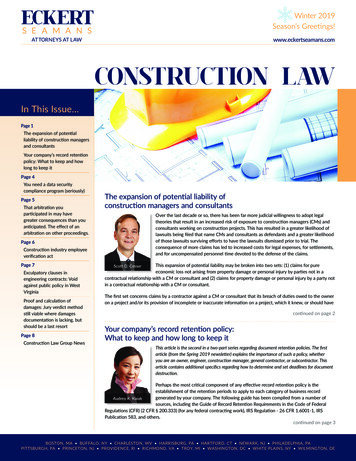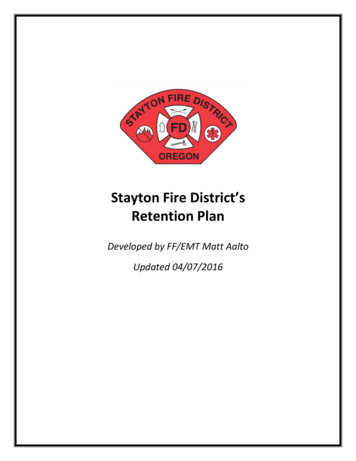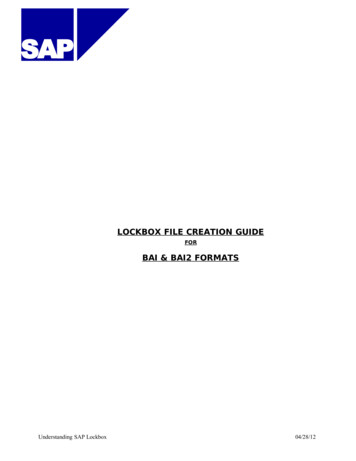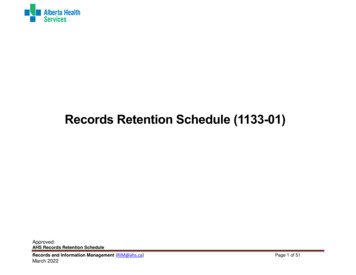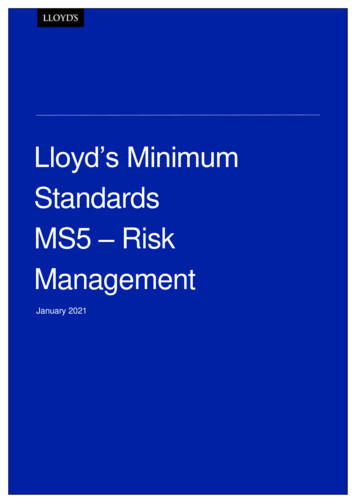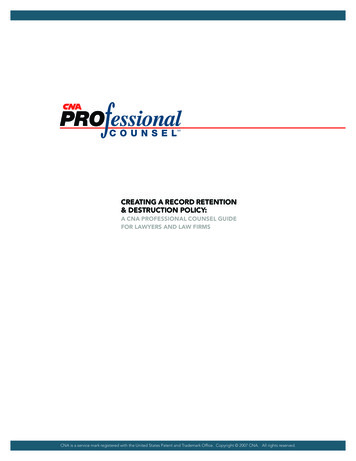
Transcription
CREATING A RECORD RETENTION& DESTRUCTION POLICY:A CNA PROFESSIONAL COUNSEL GUIDEFOR LAWYERS AND LAW FIRMSCNA is a service mark registered with the United States Patent and Trademark Office. Copyright 2007 CNA. All rights reserved.
Executive Summary Law practice has always been document and data intensive. The advent of digital technology has drastically increasedthe volume and complexity of records handled by lawyers in practice, making it impossible to adequately deal with themon an ad hoc basis. In this day and age, it is critical for lawyers and firms to develop and follow a Records ManagementPlan (RMP), a cohesive set of formal procedures for managing and maintaining records used in their practice. A comprehensive RMP sets forth policies and procedures addressing the entire lifecycle of all information and datahandled by a lawyer or firm. While all aspects of the RMP are important, this Guide focuses on perhaps the most criticalcomponent of such a plan, the Record Retention and Destruction Policy (RRD Policy). This Guide is intended to steer lawyers and firms through the numerous steps involved in creating an RRD Policy for thesafe maintenance and disposition of client matter files. Future publications will examine other components of the RMP,including policies and procedures for active file creation and maintenance and use of technology for communicationand data security. To establish an effective RRD Policy, it is important to distinguish among the various types of records within the firm,including firm records and client matter and work product records. Each record has a distinct significance to a firm orclient and may be subject to different rules and regulations regarding retention, making it necessary to maintain somerecords longer than others. When making these distinctions, it is important to consider the content over the format ofthe material or information in question. An effective RRD Policy will call for file preparation and archiving at the close of each client matter. All retentionperiods should begin with a standardized initial retention period followed by further file review to determine whetherlonger retention is required. Factors to consider when setting initial retention periods include jurisdictional rules andregulations, malpractice statutes of limitation, ethics rules, and the firm’s financial, technological and physical resources.There is no value in keeping all records forever, and law firms should aim to dispose of records that are no longer activeor subject to regulatory or legal retention requirements. Developing an effective RRD Policy takes time and effort. RRD Policies should be committed to writing in every firm,including solo practices. Comprehensive training, including consideration of how to communicate with the client aboutthe policy, is essential.2
CREATING A RECORD RETENTION AND DESTRUCTION POLICYCREATING A RECORD RETENTION & DESTRUCTION POLICY:A CNA PROFESSIONAL CounSel GUIDE FOR LAWYERS & LAW FIRMSLaw practice has always been document intensive. But now, for many lawyers, the explosive growth of digital technologyhas virtually revolutionized their practice. Lawyers and firms must manage an increasing amount of documents and data,both physical and digital, over a vast array of constantly evolving devices and media. Recent sanctions and adverse rulingsrendered against clients and their counsel for destroying potentially relevant records have put lawyers on notice of anenhanced duty to prevent the spoliation of records, both paper and electronic. In the wake of the collapse ofEnron and Arthur Anderson, numerous legislative enactments, including amendments to federal discovery rules, havegreatly enhanced the accounting, legal and ethical obligations of corporate officers and their counsel to preserve andproduce records.In light of this, lawyers and law firms can no longer rely on ad hoc record-keeping methods as sufficient, if they evercould at all. It is critical for lawyers and law firms to develop and follow a cohesive set of procedures for managing andmaintaining the records used in their practice – both their own internal records and the records of their clients with whichthey are entrusted – and to apply these procedures over their entire lifecycle, from creation to final disposition.Although it can be called many things, such a set of procedures will be referred to in this Guide as a RecordsManagement Plan.Records Management Plans Help Manage Professional Liability RiskA Records Management Plan (RMP) is a comprehensive set of procedures to manage a law firm’s information anddata. The scope of a RMP must be all-encompassing, applying to all information or data handled within the organizationand governing the conduct of every attorney and employee.Formal RMPs provide guidance to firm personnel about their responsibilities and help manage risk in a number of ways: They help lawyers fulfill their ethical obligations to protect client confidences and preserve client property byinstituting checks and review procedures before information is stored, shared, disseminated, or destroyed, making itless likely that the information will be inadvertently released to unauthorized recipients. A rational and consistent RMP helps reduce misunderstandings with clients about responsibility for maintainingrecords and allows lawyers to inform clients of the time frames and procedures for destruction of firm recordsrelating to their matters. Well-organized files facilitate responses to client inquiries about the progress of matters, billings and other issues,often allowing disputes to be resolved before claims develop. Formal file closing and storage procedures help delineate the end of work on a matter. This helps support theposition that file closing marks the beginning of limitations periods for bringing professional liability claims andassists in distinguishing between current and former clients, a key issue when considering conflicts of interest. When professional liability claims do occur, the ability to easily access case file documentation is valuable to theirdefense. Documentary evidence of the terms of representation and the respective duties and obligations of theparties can limit open-ended fiduciary obligations. Evidence of instructions given, advice rendered, and clientunderstanding is often the key to an effective defense. Conversely, cases have been lost when lawyers cannotproduce documentary evidence to counter client allegations of negligence or other professional failures.3
Scheduled file preservation and destruction pursuant to a formal RMP is reasonable and can help demonstratecompliance with ABA Model Rule 1.16(d) regarding lawyers’ obligations to clients upon termination ofrepresentation, as well as ABA Comm. On Ethics & Prof’l Responsibility Informal Opinion 1384 (1977) (Dispositionof a Lawyer’s Closed or Dormant Files Relating to Representation of or Services to Clients). Additionally, formalizeddestruction cycles can provide the impetus many lawyers need to clear their files, purge unneeded information andmore efficiently manage the historical knowledge in their firm. Implementation and enforcement of a formal RMP can avail lawyers of “safe harbors” under the Federal Rules ofCivil Procedure regarding discovery of electronically stored information, protecting the interests of the lawyer andlaw firm if documents are no longer available for discovery should malpractice litigation arise.For these reasons, lawyers and law firms, like other business organizations, must act responsibly and consistently inhandling the information and records they create, use and exchange on a daily basis. A formal, written RMP provides cleardirection to law firm staff about how records should be created and maintained, how long they should be kept, how theyshould be destroyed, and who should oversee the process. It also provides guidance about implementation, enforcement,and communication with clients about document handling. While preparing a written policy requires an initial investmentof time and effort, it establishes a consistent approach to records management that becomes an integral part of the firm’squality control program and facilitates training of new employees.Record Retention and Destruction Policy:A Key Component of a Records Management PlanBest practices suggest that lawyers and law firms should develop a RMP to govern all of their law practice records. Whilea comprehensive RMP will address all aspects of the handling of records at every stage of their lifecycle including, forexample, file creation, communication with clients, and data privacy and security, this Guide focuses on perhaps the mostcritical component of the RMP, a policy governing the handling of records at the close of a representation, commonlyreferred to here as a Record Retention and Destruction Policy.A Record Retention and Destruction Policy (RRD Policy) is a component of an overall RMP that establishes whichrecords are retained, in what manner, and for how long, as well as procedures for their release or destruction by the firm. Atruly effective RRD Policy will be rigidComponentsenough to applyall records handledOfconsistentlyA Records toManagementPlan by the firm and flexible enoughto effectively address changes in technology, laws or ethics rules that affect record handling.Components of a Records Management PlanIdentification/classification ofrecords4Policies andProceduresPolicies andProceduresCreation of recordsUse andmaintenance ofactive recordsRecord Retentionand DestructionPolicy*Implementationand enforcementPolicies andProceduresPolicies andProceduresPermanentdestruction ofretired recordsArchiving ofinactive records
Establishing an Effective Record Retention and Destruction PolicyThis document is intended to guide lawyers and law firms through the various steps of creating and implementing aneffective RRD Policy as part of a comprehensive RMP, focusing on client/matter records from specific representations.It is designed to follow the process from beginning to end, offering suggestions for review, research and analysis whencalled for, and offering particular suggestions for policy choices when appropriate. While it presents a prototype policy,it is not intended to suggest a specific set of policies or procedures, as these should be customized for each firm and itsareas of practice specialization. It is designed to help individual organizations and lawyers make informed decisions asthey undertake this important process.Preliminary Steps Prior to Developing a Record Retention and Destruction PolicyDeveloping a RRD Policy takes time and effort. It requires coordination of people, processes and technology to minimizethe risks and optimize the benefits of implementing a program for dealing with vast amounts of data and records,both paper and electronic. In larger firms the records management infrastructure could include a records custodianand designated lawyers responsible for oversight of the entire process. In smaller firms, there may be no dedicatedinfrastructure, but simply an investment of time dedicated to studying these issues and developing written policies andprocedures.Firms of all sizes – including solos – should aim to create a written policy that can be referred to by anyone else in thefirm, by those responsible for the conduct of business in the event of a lawyer’s disability or death or other firmdissolution, and (at least in part) by clients. Committing the policy to writing facilitates compliance and self-auditing forall lawyers and employees.Begin by identifying and classifying records to be covered by the policy. Before developing rules regarding thehandling of records, it is important to define what constitutes a “record” and what does not. Not all information or dataproduced or used by lawyers is an actual record. While records need to be maintained by a lawyer or firm beyond thetermination of a representation, non-records need not be. Non-records v. records. Some information or data produced or used by lawyers does not rise to the level of a recordat all. These “non-records” include routine administrative data or communications, transient memoranda or notes,and unused or insignificant drafts or copies having such limited and short-term value or usefulness that they need notbe maintained. Appropriately classifying records and non-records according to their content and importance ratherthan by format alone is essential when developing the RRD Policy.1 Non-records can be destroyed at any time, beforeor after termination of the engagement, unless subject to a discovery hold, discussed below. The most efficientapproach is to encourage immediate disposal of non-records once they are no longer needed, to avoid clutteringthe file with unnecessary data and to make file review upon closing a matter less time-consuming. At a minimum, asdiscussed below, non-records should be purged from the file before initial archiving.Next, classify the records to be covered by the policy. Law practice records can be classified into two basiccategories: firm records and client records. An effective RRD Policy should address both types to effectively manage alltypes of records.1 For example, consider the manner in which lawyers commonly use e-mail. Increasingly, lawyers transmit critical files and documents to colleagues, clients, or opposingcounsel by attaching them to e-mails. While these e-mails often serve as mere “cover letters” for such transmissions, the documents transmitted can be critical client or firmrecords. Thus, it is not appropriate to classify all e-mails as non-records and all e-mail attachments as critical client records, nor should either the e-mails or attachments beclassified based solely upon their format.5
irm records are the internal documents and data a lawyer or firm generates or uses to manage the law practice thatFare unrelated to any specific client or matter. They include items like the firm’s charter and by-laws, organizationalor administrative directives and communications, general accounting and tax records, employee compensationand payroll records, and internal time-keeping records. They are essential to the firm’s management and on-goingexistence. While not typically shared outside of the firm, firm records can be important to the defense of a malpracticeor disciplinary action. Client records correspond to each engagement or representation undertaken by the lawyer or firm. They consist ofdocuments generated by or exchanged between lawyer and client to facilitate the legal services being rendered anddocuments generated as a result of research or discovery performed on the client’s behalf. This category of recordscan be broken down further into two subcategories, case matter records and work product records: Case matter records relate to the specific matter or engagement. These include records or documents receivedfrom the client for the attorney’s review and reference, or other client property delivered to the attorney inthe course of the representation. Engagement letters and/or fee agreements for specific matters and recordsof communications between the lawyer and client relating to the engagement such as written and e-mailcorrespondence and billing records are also included. Examples of other case matter records include the endproducts of any legal advice or services provided by the attorney to the client during the engagement, suchas communications and documents filed or made public in furtherance of the client’s interests, and any legaldocuments or instruments produced, such as fully-executed contracts, wills, deeds or other documents that havelegal significance to the specific matter. They may also include summaries of research requested by the client, orthe fruits of discovery generated as part of the representation. Work product records are records and documents produced by the lawyer or firm relating to the client orengagement intended only for internal firm reference. Examples include the firm’s internal correspondence, draftsof documents created for review or use within the firm, and attorney notes reflecting the internal impressionsof the client or the client’s matter. They also include the fruits of any general legal research or investigation notundertaken for a specific client.A RRD Policy should include policies and procedures on treatment of both firm records and client records. Firmrecords are often retained longer than client records, usually because they have relevance to more than one matter orconcern (examples include conflicts checking memos, which may be significant for matters relating to more than oneclient, or docketing system procedure manuals). Some firm records should be kept indefinitely, as in the case of a firm’scorporate charter or partnership agreement. Also, some states set mandatory retention periods for certain firm recordsand/or client records. For example, almost every state has established a specific retention period for records relating tolaw firm fee trust accounts or other records reflecting lawyers’ handling of client funds.2Next, identify who will be responsible for development of the RRD Policy. Larger firms should begin the processby forming a committee that includes lawyers from each firm practice area, firm management, administration, informationtechnology (IT), and competent legal counsel with experience in defending professional malpractice claims. Suchexpertise may come from inside or outside the firm, as available. Solos and small firms may need to consult with outsidevendors regarding IT issues.32 For a chart summarizing the specific retention periods set by various states, see Appendix A.3 In recent years, the market has seen a sharp increase in the number of vendors specializing in records management and data storage for law firms. In general, these vendorstend to focus on the end of the record retention and destruction process – archival storage or disaster back-up and recovery. While both are important components of a RRDPolicy, they are not the only aspects to address. Firms consulting with such vendors should ensure that the full range of records management issues is considered whendeveloping a policy.6
Next, audit current RRD procedures to gain an understanding of how files are currently handled. Sample bothindividual and group practices and procedures, whether formalized or not. This allows insight into the consistency orlack thereof in firm record handling and will raise good ideas for inclusion in the formal policy. Document the findings forlater reference.Then, identify and articulate any technological or financial constraints that may affect the planning process.Planners need to have an understanding of their financial and technological limitations to make prudent and practicablesuggestions for a RRD Policy. Develop a preliminary budget that considers these limitations and specifies the parametersof acceptable and achievable technological change.Once these preliminary steps are completed, it is time to develop and implement the various planks of thesubstantive policy. When the policy has been decided upon, the firm should commit it to writing and distribute it to allfirm personnel. The policy also should be condensed into summary form and distributed to clients. (The client documentshould summarize only the firm’s approach to the retention and destruction of case matter records, as the maintenance offirm records and work product records is an internal firm management policy that need not be disclosed to clients.)Developing and Implementing the RRD PolicyThe RRD Policy should provide step-by-step guidance on when and how to retain and destroy designated firm recordsand client records. It should include processes to test the effectiveness of these procedures to achieve desired goalsand to measure implementation of and compliance with the procedures. It should address document review processes,backup and archival procedures, online storage repositories, the designation and responsibilities of record custodians,and the creation and maintenance of a destroyed documents log. The importance of effective and regular trainingabout the RRD Policy should also be addressed. Firms should plan for formal training of all firm personnel prior toimplementation, and this instruction should also be included in the training curriculum for every new employee.While a RRD Policy for firm records is important and should be articulated, client records (including both case matterrecords and work product records) are handled more frequently by a broader range of law firm employees. The rest of thisGuide is intended to provide a prototype method for developing that portion of the policy.7
Case Matter/Work Product Record Retention and Destruction:Step-By-StepThe first issue to address is where in the lifecycle of a matter the RRD Policy should be applied. When talkingabout client matter records generally, the short answer is when the matter ends. For the purpose of applying a RRDPolicy, files relating to specific matters should be treated as closed files when the lawyer and firm have completed allservices promised relating to that matter, whether for on-going clients or for single-matter clients. This helps delineatethe beginning of any applicable limitations period for filing professional liability lawsuits regarding the particular matter.4If the work was done for an on-going client and some of the data or documents may be needed for future reference inlater matters, it should be specifically moved at the close of the matter from the case matter file to a firm-wide activeknowledge management system where it can be accessed as necessary.Once it has been established that the matter has ended, the step-by-step process should begin.Step 1. Gather relevant file materials from all personnel to create one “official” file.Even in solo practices or firms with only a few attorneys, records may be scattered in several places and exist in severalformats. Electronic data is regularly duplicated in the ordinary course of its creation and distribution. Copies may reside incentral servers, home computers and desktop hard drives, back-up disks and e-mail folders. All legal assistants, secretariesand attorneys who worked on the matter will likely possess relevant material in either electronic or paper formats. Anindividual most familiar with the work done and the staffing of the matter (often a legal assistant or paralegal) should bedesignated to gather this material for review and preparation for retention or destruction. E-data should be cataloguedand identified to facilitate retrieval in the later stages of the process.The process should encompass both paper documents and records maintained electronically on other storagemedia. This includes, for example, microfilm, microfiche, electronic data on tape, computer hard drives and servers,personal digital assistants, and portable data storage devices such as flash drives, hard drives and disks. Electronic dataincludes, but is not limited to, e-mail and other electronic communications, word processing documents, spreadsheets,databases, calendars, telephone logs and voice mail, Internet and computer usage files, network access information, andall associated metadata.5Step 2. Prepare the retained file for archiving.Although it is relatively easy to maintain large volumes of data electronically, there is no need to keep everything in thefile when archiving at the close of a matter, nor is this prudent. Storing records is costly and time-consuming. Expensesinclude physical storage space and storage media costs, from filing cabinets and warehouse space to digital recordstorage devices. Additionally, storing all records increases the cost of researching and retrieving records when needed,and needlessly complicates responses to discovery requests for records, especially electronically stored information. Inlight of this, the RRD Policy should provide guidance for paring of files prior to long-term storage.4 In some jurisdictions, the limitations period for filing suit based on attorney malpractice does not begin to run until the attorney-client relationship has concluded, at leastwith respect to the matter that is the subject of the suit. This approach is based on a public policy argument that clients should not be compelled to sue their attorneys whilethe attorneys are still obliged to act as their agents and fiduciaries. In such jurisdictions delineating the end of the representation through file closing at the conclusion of thematter can help avoid the unintended extension of the limitations period.5 Metadata is vital information hidden within an electronic file about the file data. Some examples of metadata include the file’s name, location, format, size and type, aswell as information describing how, when, and by whom the file was created, accessed, and modified, and the dates and times of each modification. Each time a document is opened, even if it is being done only to save a copy, new metadata is created. Duplicates of existing electronic documents contain different metadata than the originaldocument. Under discovery rules, such documents would likely be considered to be unique. In most circumstances this suggests that unless the RRD Policy requires duplicatesof electronic files to be maintained in different locations for business reasons, duplicate files should be destroyed upon closing of a client matter file. For more informationabout metadata, see “Understanding Metadata,” at awyersinsurance/html/rmanagement.html8
First, confirm that non-records have been removed from the file. This could include exact duplicates of records, copies ofcases or other published material used for research or study purposes, junk mail, internal or personal notes, andextraneous or misfiled materials.Next, remove any firm records from the file. As a matter of efficiency and good records management, firm recordsgenerated in connection with specific engagements should be stored centrally with other like firm records at the time theyare created rather than being maintained in the active client matter file. Nevertheless, there may be some firm recordsstored in the file, including billing records, conflicts searches or memos, or trust account information. These shouldbe removed and filed with other like records, keeping duplicates in the archived file or an index of what was removed.Research memos that are appropriate for deposit in the firm’s central knowledge management archives can be removedto other storage and indexed, or duplicated and filed in both places. Create an index of memo topics and case names,noting the new location of research memos or other documents, and destroy “hard copies” of documents that are nolonger needed or will be archived electronically.6Remove and index reproducible records. To save on expenses and space, firms can create an index of materials thatcan be retrieved from libraries, on-line services or court files, rather than maintaining copies in the archived file. The costsavings should be balanced against the risk that these service providers may fail or lose the items, the ease of retrieval,and how long those places will likely keep the materials.Lawyers and firms should retain in the archived file any evidence of communication with the client regarding therepresentation, including engagement letters, bills, update letters, transmittal letters and the like. Likewise, they shouldkeep single copies of all final work product, including final contracts, judgments, briefs, settlement agreements, or otherfinal original work created as part of the representation.7 These documents can be critical in resolving client disputes thatcould arise at a later date, in pursuing unpaid fees, and in defending attorney malpractice claims.Whether or not to save drafts of final contracts is subject to debate: Some commentators recommend it because thedrafts provide insight into the thought process of the client and the lawyer, which can be helpful in resolving disputesbetween the parties to the contract or between lawyer and client. This suggests that the RRD Policy could include arequirement to archive drafts of negotiated documents. However, there is little to support an argument to retain draftsof litigation documents. If capacity allows, it is acceptable to keep litigation drafts, but it is unlikely they will be neededin connection with the closed matter in the future. Drafts of settlement agreements that show the course of negotiation,however, arguably ought to be treated like drafts of contracts, and the RRD Policy should address the applicable retentionperiod.Responsibility for preparing files for long-term storage can be delegated to paralegals or other non-lawyer staff ifthe RRD Policy is clear and straightforward, but the lawyers that handled each matter should remain responsible foroversight of the process. The RRD Policy should instruct the closing attorney to consider during his or her reviewwhether the file contains information that should be added to the firm’s conflicts database, such as names of adversewitnesses, expert witnesses, additional adverse parties, shareholders, or insurers that were not added during the courseof the representation.Step 3. Identify materials originating from the client and any other materials to which the client is entitled.Clients are generally entitled to files and records – often even work product records – that related to the client or to theattorney’s representation of the client. This includes original documents or objects delivered to the attorney by the clientfor use in pursuing the matter. This also includes working copies that the attorney may have made of the original material.6 For a sample index of items removed from archived files, see Appendix
records management Plans Help manage Professional Liability risk A records management Plan (rmP) is a comprehensive set of procedures to manage a law firm's information and data. The scope of a RMP must be all-encompassing, applying to all information or data handled within the organization and governing the conduct of every attorney and .
